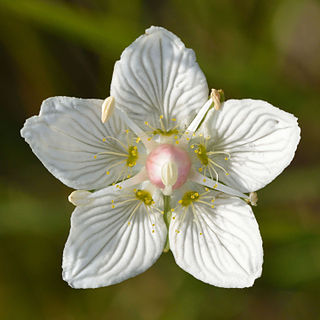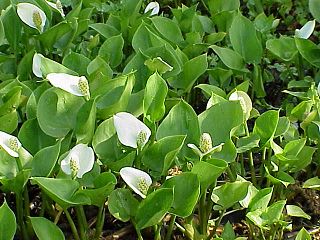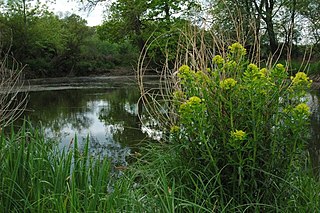Related Research Articles

Polianthes is a formerly recognized genus of plants in family Asparagaceae, subfamily Agavoideae. molecular phylogenetic studies showed that Polianthes is embedded within the larger genus Agave, which has been expanded to include it. One of its former members is the tuberose, Agave amica, formerly Polianthes tuberosa, a plant that is commonly used in perfume making.

Caltha palustris, known as marsh-marigold and kingcup, is a small to medium size perennial herbaceous plant of the buttercup family, native to marshes, fens, ditches and wet woodland in temperate regions of the Northern Hemisphere. It flowers between April and August, dependent on altitude and latitude, but occasional flowers may occur at other times.

Tabernaemontana is a genus of flowering plants in the family Apocynaceae. It has a pan-tropical distribution, found in Asia, Africa, Australia, North America, South America, and a wide assortment of oceanic islands. These plants are evergreen shrubs and small trees growing to 1–15 m tall. The leaves are opposite, 3–25 cm long, with milky sap; hence it is one of the diverse plant genera commonly called "milkwood". The flowers are fragrant, white, 1–5 cm in diameter.

Parnassia palustris, commonly called marsh grass of Parnassus, northern grass-of-Parnassus, or just grass-of-Parnassus, and bog-star, is a flowering plant in the staff-vine family Celastraceae.

Calla is a genus of flowering plant in the family Araceae, containing the single species Calla palustris.

Epipactis palustris, the marsh helleborine, is a species of orchid native to Europe and Asia.

Eleocharis palustris, the common spike-rush, creeping spike-rush or marsh spike-rush, is a species of mat-forming perennial flowering plants in the sedge family Cyperaceae. It grows in wetlands in Europe, North Africa, northern and central Asia and North America. Eleocharis palustris is not easily distinguished from other closely related species and is extremely variable worldwide itself. The species epithet palustris is Latin for "of the marsh" and indicates its common habitat.
Tabernaemontana undulata, the Becchete or Bëcchëte is a milkwood species in the family Apocynaceae. It occurs in the Amazon rainforest.
Palustris is a Latin word meaning "swampy" or "marshy", and may refer to:

Anacamptis palustris is a species of orchid. It is found in Europe, North Africa and western Asia. This orchid is native to Western and Central Europe, the Mediterranean region, the Balearic Islands, Turkey, Western Asia, Algeria and Tunisia in North Africa, and Saudi Arabia.

Thelypteris palustris, the marsh fern, or eastern marsh fern, is a fern native to eastern North America and across Eurasia. It prefers to grow in marshy situations in full sun. The species epithet palustris is Latin for "of the marsh" and indicates its common habitat. It is the only known host plant for Fagitana littera, the Marsh Fern Moth.

Ludwigia palustris is a species of flowering plant in the evening primrose family known by the common names marsh seedbox, Hampshire-purslane and water purslane. Its native distribution is unclear, but includes parts of the Americas; it can be found on most continents and spreads easily to become naturalized. It is also cultivated as an aquarium plant. This is an aquatic or semiaquatic perennial herb which grows in moist to wet to flooded areas. It is sometimes a weed. The species epithet palustris is Latin for "of the marsh" and indicates its common habitat.

Rorippa palustris is a species of flowering plant in the mustard family. It is widespread and native to parts of Africa, and much of Asia, Europe and Eurasia, North America and the Caribbean. It can also be found in other parts of the world as an introduced species and a common weed, for example, in Australia and South America. It is an adaptable plant which grows in many types of damp, wet, and aquatic habitat. It may be an annual, biennial, or perennial plant, and is variable in appearance as well.

Euphorbia palustris, the marsh spurge or marsh euphorbia, is a species of flowering plant in the family Euphorbiaceae, native to marshland throughout much of mainland Europe and western Asia. It is an herbaceous perennial growing to 90 cm (35 in) tall and wide, with narrow leaves turning red and yellow in autumn, and persistent, bright acid yellow flower-heads (cyathia), 15 cm (6 in) across, in spring.

Tabernaemontana divaricata (Apocynaceae), commonly called pinwheel floweror anupams kindi, '''crape jasmine, East India rosebayand Nero's crown is an evergreen shrub native to India and now cultivated throughout South East Asia and the warmer regions of continental Asia. In zones where it is not hardy it is grown as a house/glasshouse plant for its attractive flowers and foliage. The stem exudes a milky latex when broken, whence the name milk flower ('দুধফুল), টগর or কাঠমল্লিকা in the Bengali language..
Tabernaemontana macrocarpa grows as a shrub or tree up to 30 metres (100 ft) tall, with a trunk diameter of up to 50 centimetres (20 in). The bark is yellowish brown, brown, grey-brown or grey. Its fragrant flowers feature combinations of cream, white and orange corolla lobes. The fruit is orange, with paired follicles, each up to 16 centimetres (6 in) in diameter. The specific epithet macrocarpa is from the Greek meaning "with large fruit". Its habitat is forests from sea level to 1,500 metres (5,000 ft) altitude. Tabernaemontana macrocarpa has been used as arrow poison. The species is native to Thailand and Malesia.

Tabernaemontana pandacaqui is a species of plant in the dogbane family, Apocynaceae, known as windmill bush and banana bush. It grows as a shrub or tree up to 14 m (46 ft) tall. Its flowers feature white or pale yellow corolla lobes. The fruit is orange, red or yellow with paired follicles, each up to 7 cm (2.8 in) in diameter. The plant is found in a wide variety of habitats, particularly in drier areas. It is native to China, Taiwan, Thailand, Malesia, Papua New Guinea, Australia and many Pacific islands. The species is also reportedly naturalized in the Windward Islands, Trinidad and Tobago and Panama.
Tabernaemontana pauciflora is a species of plant in the family Apocynaceae. It grows as a shrub or small tree up to 6 metres (20 ft) tall, with a trunk diameter of up to 10 centimetres (4 in). The bark is pale grey to grey-brown. Inflorescences bear up to 15 flowers. The fragrant flowers feature white, sometimes yellow-throated, corolla lobes. The fruit is orange or yellow with paired follicles, up to 6 centimetres (2 in) in diameter.
Tabernaemontana rostrata grows as a shrub up to 2 metres (7 ft) tall. Its flowers feature a white corolla. The habitat is scrub or forest to 1,400 m (4,600 ft) altitude. The species is native to Bangladesh, Indo-China and Malesia.
Tabernaemontana sananho is a tropical tree species in the family Apocynaceae. Lobo sanango grows in the Amazon Basin of northern South America.
References
- ↑ "Tabernaemontana palustris Markgr". World Checklist of Selected Plant Families (WCSP). Royal Botanic Gardens, Kew . Retrieved 22 May 2014– via The Plant List.
- ↑ Archibald William Smith A Gardener's Handbook of Plant Names: Their Meanings and Origins , p. 258, at Google Books
- ↑ Duke, Alan James; Vasquez Martinez, Rodolfo (1994). Amazonian Ethnobotanical Dictionary. Boca Raton: CRC Press. p. 164. ISBN 0-8493-3664-3 . Retrieved 31 May 2014.
| This Apocynaceae article is a stub. You can help Wikipedia by expanding it. |